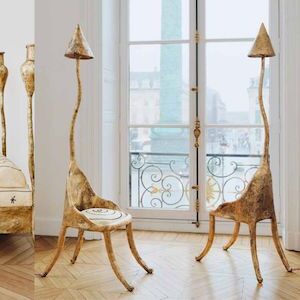Ratio; Dorothea Tanning: Between Crafts
By George Kowalik
Dorothea Tanning lived a very long, very productive life. On paper, it makes quite disconcerting reading to the average you or me: she was a successful painter, printmaker, sculptor and writer. She published two memoirs, two books of poetry, a novel, and has countless artistic works in galleries across the US and everywhere outside – from Jerusalem and Barcelona to Rome and Cambridge. She was a tremendously prolific, truly singular creative mind that we can only be in awe of.
At the centre of everything was her painting. Both influenced by and influencing twentieth century Surrealism, her most revered works are invariably strange yet fascinating, challenging yet rewarding. See Eine Kleine Nachtmusik (1943), On Time Off Time (1948), Insomnies (1957), or Still in the Studio (1979): each work is a rabbit hole of mystery and intrigue. You’ll struggle to describe what exactly you’re looking at, but you won’t be able to look away.
 Eine Kleine Nachtmusik, on display at the Tate Modern
Eine Kleine Nachtmusik, on display at the Tate Modern
Many of these are held at the current showcase of her life and work at the Tate Modern, running until 9th June. It is the first large-scale exhibition of her work for 25 years, bringing together the iconic paintings from her seven-decade career, but also many of the sculptures, such as Hôtel du Pavot, Chambre 202 (1973), Étreinte (1969), and Nue couchée (1969-1970):
Hôtel du Pavot especially is daunting in size but overwhelming in effect. As a first-hand experience it’s unforgettable. It receives its own room of the exhibition’s eight. Appropriately, the Tate’s physical space offers entrances, exits and doorways, but never to restrict one room or isolate it from any of the others; it accommodates an artist that frequently returned to a surrealist interpretation of the door symbol. The image provides a background to many of her early works, but it becomes the focal point of the later pieces:
 Door 84 (1984), a centrepiece of room two. The exhibition programme subtitles this area “Behind the Door”
Door 84 (1984), a centrepiece of room two. The exhibition programme subtitles this area “Behind the Door”
Doorways to other creative worlds are what Dorothea Tanning lived by. Alongside the artwork, her first short story was published in VVV Magazine in 1943 and her poetry appeared in the likes of The Yale Review, The Paris Review and The New Yorker throughout the ‘80s. Her first memoir – Birthday, named after the 1942 self-portrait she’s still remembered for today – was published in 1986, and a second (Between Lives) came out in 2001. By her death in 2012, her two poetry collections and novel had also been released.
Some of her contemporaries were equally multi-talented, ranging from painter/sculptor Marcel Duchamp to Joseph Cornell, known for assemblage and experimental filmmaking. There’s perhaps no better example than Salvador Dalí, who opened the floodgates for cross-medium creative output. Famously, he’s responsible for seminal works in multiple art forms: he painted The Persistence of Memory (1931) and co-created short film Un Chien Andalou with Luis Buñuel (1929).
A modern-day example would be someone like Tom Ford, the fashion designer who launched his own brand in 2006 and directed the Oscar-nominated films A Single Man (2009) and Nocturnal Animals (2016). Or Nick Cave: frontman of three bands, writer of two novels, two books of poetry, three screenplays, and responsible for over a dozen feature film musical scores.
This kind of master of all crafts isn’t exactly mass-produced by the creative industries. Dorothea Tanning offered something special in her mid-twentieth century heyday; but it is something no less vital today.
For details, dates and tickets to the exhibition at the Tate Modern, click here






